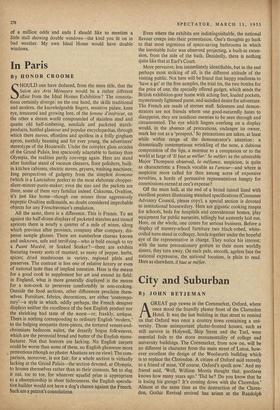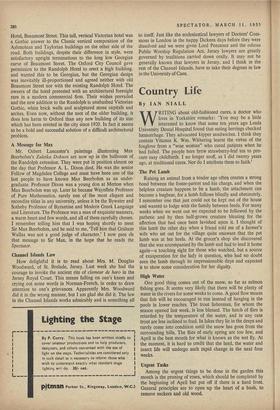City and Suburban
By JOHN BETJEMAN AGREAT gap yawns in the Cornmarket. Oxford, where once stood the friendly plaster front of the Clarendon Hotel. It was the last building in that street to remind us that Oxford was once a country town containing a uni- versity. Those unimportant plaster-fronted houses, such as still survive in Holywell, Ship Street and the Turl, were essential foils to the stone monumentality of college and university buildings. The Cornmarket, from now on, will be no different in character from the main street of Luton, how- ever excellent the design of the Woolworth building which is to replace the Clarendon. A citizen of Oxford said recently to a friend of mine, 'Of course, Oxford's spoilt now.' And my friend said, 'Well, William Morris thought that, goodness knows how many years ago.' Did he? Do you know that he is losing his garage? It's coming down with the Clarendon.' Almost at the same time as the destruction of the Claren- don, Gothic Revival revived has arisen at the Randolph Hotel, Beaumont Street. This tall, vertical Victorian hotel was a Gothic answer to the Classic vertical composition of the Ashmolean and Taylorian buildings on the other side of the road. Both buildings, despite their difference in style, were satisfactory upright terminations to the long low Georgian curve of Beaumont Street. The Oxford City Council gave permission to the Randolph Hotel to erect a high building, and wanted this to be Georgian, but the Georgian design was inevitably ill-proportioned and agreed neither with old Beaumont Street nor with the existing Randolph Hotel: The owners of the hotel protested with an architectural foresight rare in a modern commercial firm. Their wishes prevailed and the new addition to the Randolph is unabashed Victorian Gothic, white brick walls and sculptured stone capitals and arches. Even now, without the soot of the older building, it does less harm to Oxford than any new building of its size' which has been erected in the city since 1920. In fact it seems to be a bold and successful solution of a difficult architectural problem.
A Message for Max Mr. Osbert Lancaster's paintings illustrating Max Beerbohm's Zuleika Dobson are now up in the ballroom of the Randolph extension. They were put in position almost on the day that Professor A. L. Dixon died. He was the senior Fellow of Magdalen College and must have been one of the last people to have known Max Beerbohm as an under- graduate. Professor Dixon was a young don at Merton when Max Beerbohm was up. Later he became Waynflete Professor of Pure Mathematics, surely one of the most elegant and recondite titles in any university, unless it be the Bywater and Sotheby Professor of Byzantine and Modern Greek Language and Literature. The Professor was a man of exquisite manners, a warm heart and few words, and all of them carefully chosen. I remember telling him that I was hoping shortly to meet Sir Max Beerbohm, and he said to me, 'Tell him that Graham Wallas was not a good judge of character.' I now pass On that message to Sir Max, in the hope that he reads the Spectator.
Channel Islands Law How delightful it is to read about Mrs. M. Douglas Woodward, of St. Brelade, Jersey. Last week she had the courage to invoke the ancient rite of clameur de haro in the Jersey Royal Court. This means falling on one's knees and crying out some words in Norman-French, in order to draw attention to one's grievances. Apparently Mrs. Woodward did it in the wrong manner, but I am glad she did it. The law in the Channel Islands works admirably and is something all to itself. Just like the ecclesiastical lawyers of Doctors' Com- mons in London in the happy Dickens days before they were dissolved and we were given Lord Penzance and the odious Public Worship Regulation Act, Jersey lawyers are greatly governed by traditions carried down orally. It may not be generally known that lawyers in Jersey, and I think in the rest of the Channel Islands, have to take their degrees in law in the University of Caen.











































 Previous page
Previous page